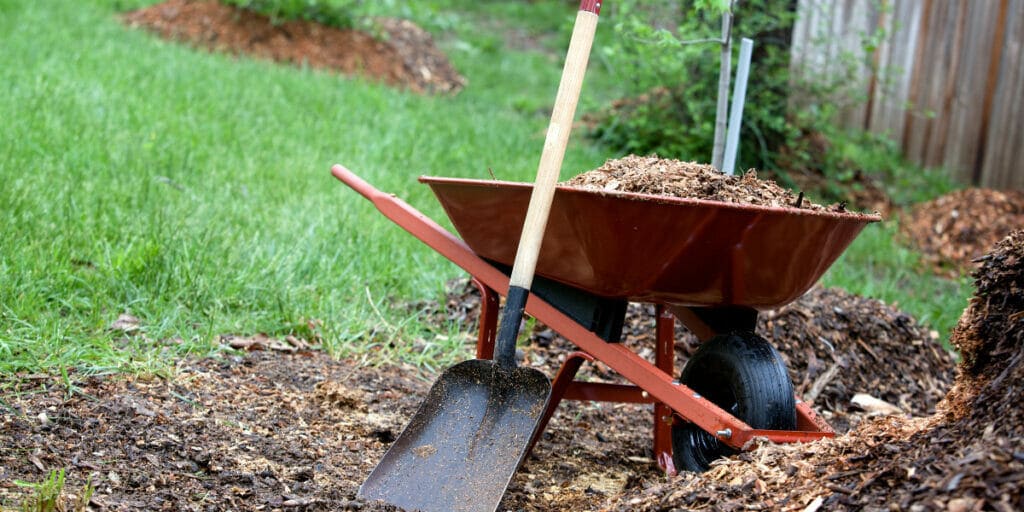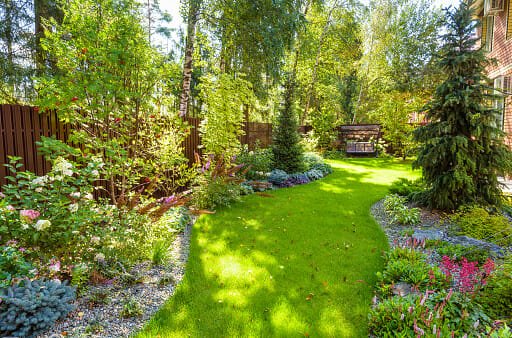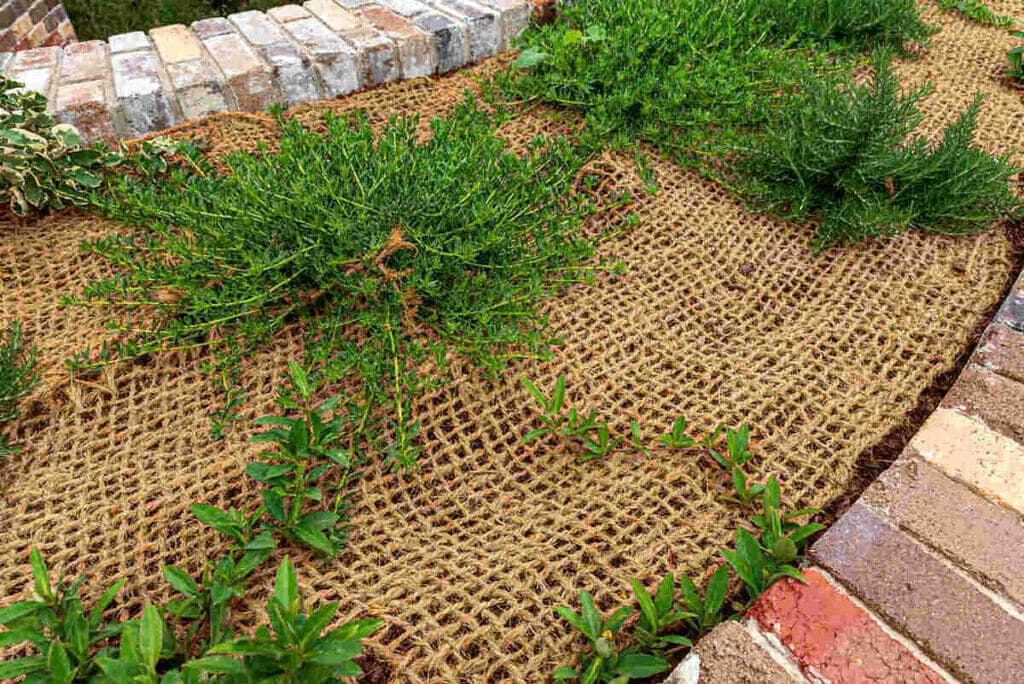Easy Landscape Design: A Beginner’s Guide to DIY Beauty
Landscape design is integral to creating visually appealing and functional outdoor spaces. Its significance extends beyond mere aesthetics, playing a pivotal role in enhancing the quality of our lives. In this blog post, we will delve into the multifaceted world of landscape design, exploring its aesthetic allure and its numerous practical advantages.
Landscape design isn’t just about arranging plants and stones; it’s about sculpting environments that foster relaxation, recreation, and connection with nature. A well-designed landscape can increase property value curb appeal and contribute to environmental sustainability by promoting biodiversity and reducing energy consumption.
Embarking on your landscaping project can be rewarding. It allows you to personalize your outdoor space and provides a sense of accomplishment and cost savings. We’ll discuss tips, ideas, and steps to guide you through the DIY landscaping process.
We’ll explore the principles of landscape design, share DIY landscaping techniques, discuss the selection of plants and materials, and provide inspiration for transforming your outdoor space into a harmonious oasis that reflects your unique style and personality. Whether you’re a seasoned gardener or a novice enthusiast, this post aims to empower you with the knowledge and inspiration to embark on your landscaping journey. So, let’s dive into the world of landscape design and unlock the potential of your outdoor space.
Assess Your Space
Assessing your space is crucial in landscaping, laying the foundation for a prosperous and harmonious outdoor environment.
Here’s an expanded look at the critical components of this process:
- Understanding your climate zone: Research your climate zone, as this will significantly influence plant selection and maintenance. Knowing your location helps you choose plants well-suited to your region’s temperature, precipitation, and seasonal variations. When planning your landscape, it’s essential to consider factors like frost dates, drought tolerance, and extreme weather conditions.
- Determining soil type: Soil composition is pivotal in plant health and growth. Conduct soil tests to determine its pH level, nutrient content, and drainage properties. Different plants thrive in various soil types, so understanding your soil’s characteristics will enable you to make informed decisions regarding soil amendments and plant selection.
- Identifying existing features and challenges: Evaluate your space for existing features like mature trees, slopes, drainage patterns, and any hardscape elements. Identifying challenges such as poor drainage, erosion, or limited sunlight helps you plan around them or address them effectively in your landscaping design.
- Setting goals and priorities for your landscape: Clearly define your goals for the outdoor space. Are you creating a relaxing retreat, a functional vegetable garden, or an entertaining area? Prioritize your objectives to ensure your landscape design aligns with your vision and budget.
By thoroughly assessing your space in these four aspects, you’ll be better prepared to make informed decisions, create a landscape that thrives in your specific environment, and ultimately enjoy the outdoor space you’ve envisioned.
Design Principles for Beginners
Balance and symmetry
“Balance and symmetry” are fundamental design principles in creating visually appealing and harmonious compositions.
- Creating a focal point: Focal points draw the viewer’s attention to a specific area of your design. They can be achieved through contrast in size, color, or placement. A well-placed focal point helps convey your plan’s intended message or purpose, guiding the viewer’s gaze and making your design more engaging.
- Achieving visual balance: Balance refers to the distribution of visual elements within a design to create a sense of stability and equilibrium. Achieving balance doesn’t necessarily mean perfect symmetry; it can also be asymmetrical, where parts of different visual weights are arranged harmoniously. Asymmetrical balance can often create a more dynamic and exciting composition. Ratio ensures that no single element overpowers the others, promoting a sense of cohesion and ease for the viewer.
Incorporating these principles into your designs can greatly enhance their visual impact and make them more aesthetically pleasing and practical. Balance and symmetry are valuable tools for beginners and experienced designers to achieve their goals.
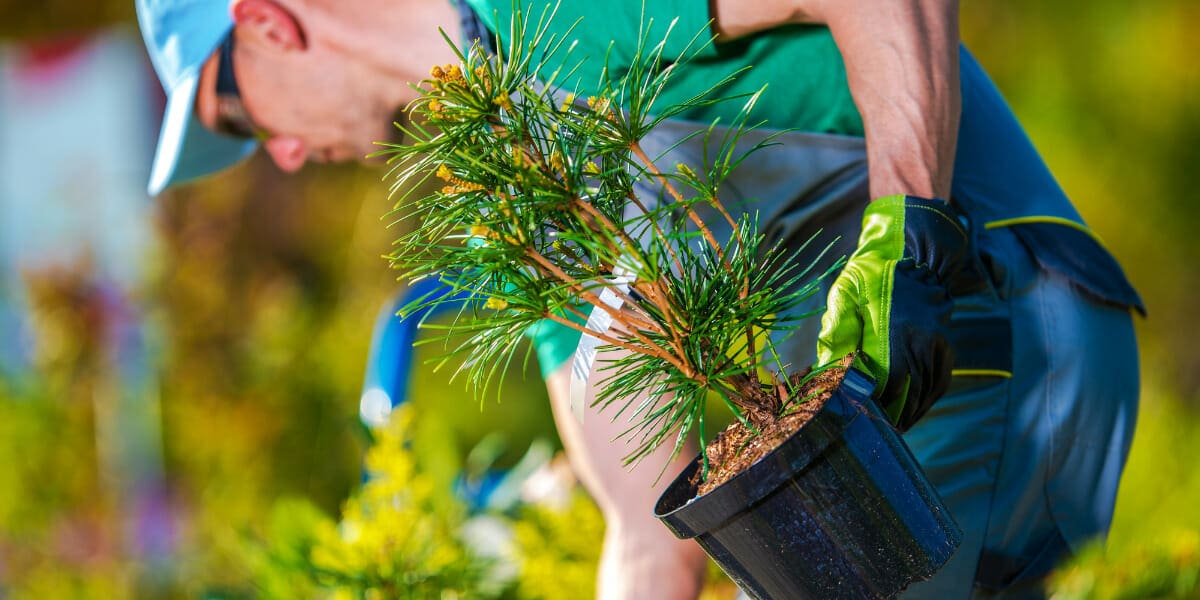
Scale and proportion
“Scale and proportion” is a fundamental aspect of design principles for beginners in landscaping and interior design. It involves two key elements:
- Choosing appropriate plant sizes: When designing landscapes or interiors, selecting the right-sized plants is crucial. Oversized plants can overwhelm a space, while undersized ones might get lost. Beginners should consider the available space and how plants will fit into it. For outdoor landscaping, trees, shrubs, and flowers should be chosen based on their eventual size, ensuring they don’t overcrowd or underwhelm the area. Similarly, selecting appropriately sized furniture and decor items in interior design is essential to maintain balance and functionality.
- Ensuring harmony in design: Scale and proportion help achieve visual peace in a plan. This involves maintaining a sense of balance and cohesion between different elements. Beginners should aim for a harmonious distribution of sizes and proportions throughout the space, ensuring that no single part dominates the overall design. This can be achieved through careful planning, experimentation, and a keen eye for how different elements interact within the structure.
Understanding scale and proportion is vital for beginners in design, enabling them to create aesthetically pleasing and well-balanced landscapes and interiors. It involves selecting appropriate plant sizes and maintaining harmony in the overall layout, resulting in visually appealing and functional spaces.
Unity and harmony
Unity and harmony in design are fundamental principles that create a sense of balance and cohesion in visual compositions. To achieve unity and harmony, beginners should focus on two key aspects: selecting a cohesive color palette and repeating patterns and themes.
Firstly, choosing a harmonious color palette is crucial. It involves selecting colors that work well together through complementary or analogous color schemes. Beginners should consider the emotional impact of colors and how they relate to the intended message or mood of the design. A well-thought-out color palette can tie different plan elements together, creating a unified and visually pleasing result.
Secondly, repetition of patterns and themes can strengthen unity. Repeating certain elements, such as shapes, fonts, or imagery, throughout the design reinforces consistency and coherence. This repetition guides the viewer’s eye and helps them make connections between various parts of the composition, contributing to a harmonious and organized visual experience.
Incorporating these principles of unity and harmony can lead to more effective and aesthetically pleasing designs, especially for beginners looking to create visually engaging and impactful work.
Simplicity and restraint
“Simplicity and restraint” are fundamental design principles for beginners that emphasize the importance of clarity and effectiveness in design. To adhere to these principles, designers should ensure their plans are manageable. This means resisting the temptation to fill every available space with elements. Instead, prioritize the most essential information or details to convey your message effectively.
Secondly, keeping it manageable is essential. Beginners should only consider their designs with the necessary details and features. Streamlining your design makes it easier for the audience to understand and ensures a cleaner and more visually appealing result.
In essence, simplicity and restraint in design help create a harmonious and user-friendly experience. By eliminating clutter and sticking to the essentials, beginners can craft aesthetically pleasing designs and effectively communicate their intended message, making it more likely to resonate with their target audience.
Basic Landscape Elements
Hardscape features
Hardscape features are integral to a well-designed landscape, enhancing functionality and aesthetics. Paths and walkways, the first element, serve as navigational arteries, guiding inhabitants and visitors through the outdoor space. Whether crafted from stone, gravel, or concrete, they offer a sense of direction while adding character to the landscape.
Patios and decks, the second element, provide outdoor living spaces for relaxation and entertainment. These hardscape features can be made from various materials, such as wood, pavers, or composite materials, offering versatile design options to suit any style.
Fences and walls, the third element, define property boundaries, provide privacy, and create visual interest. Whether constructed from wood, stone, or metal, they contribute to the landscape’s structure and security, serving as canvases for climbing plants and decorative elements.
Incorporating these hardscape elements thoughtfully into the landscape design ensures a harmonious balance between the natural and built environment, resulting in a functional and visually appealing outdoor space.
Softscape elements
“Softscape elements” are vital components of a well-balanced landscape, contributing to its aesthetics, biodiversity, and functionality.
- Trees and shrubs: These towering and bushy plants provide shade, privacy, and visual interest to your landscape. Trees like oaks and maples offer seasonal changes in foliage, while shrubs like azaleas and boxwood can be used as hedges or focal points.
- Flowerbeds and perennials: Flowerbeds bursting with colorful blooms and perennials offer year-round beauty. They attract pollinators, add a vibrant touch, and can be strategically planted to create focal points or borders. Examples include roses, tulips, and day lilies.
- Lawn and ground cover: Lawns are the canvas of your landscape, offering a green backdrop for other elements. Ground cover plants like ivy, creeping thyme, or moss create texture, suppress weeds, and prevent soil erosion.
Balancing these softscape elements with hardscape features like patios and walkways creates a harmonious and inviting outdoor space. Careful planning and maintenance of softscapes ensure a thriving and visually appealing landscape year-round.
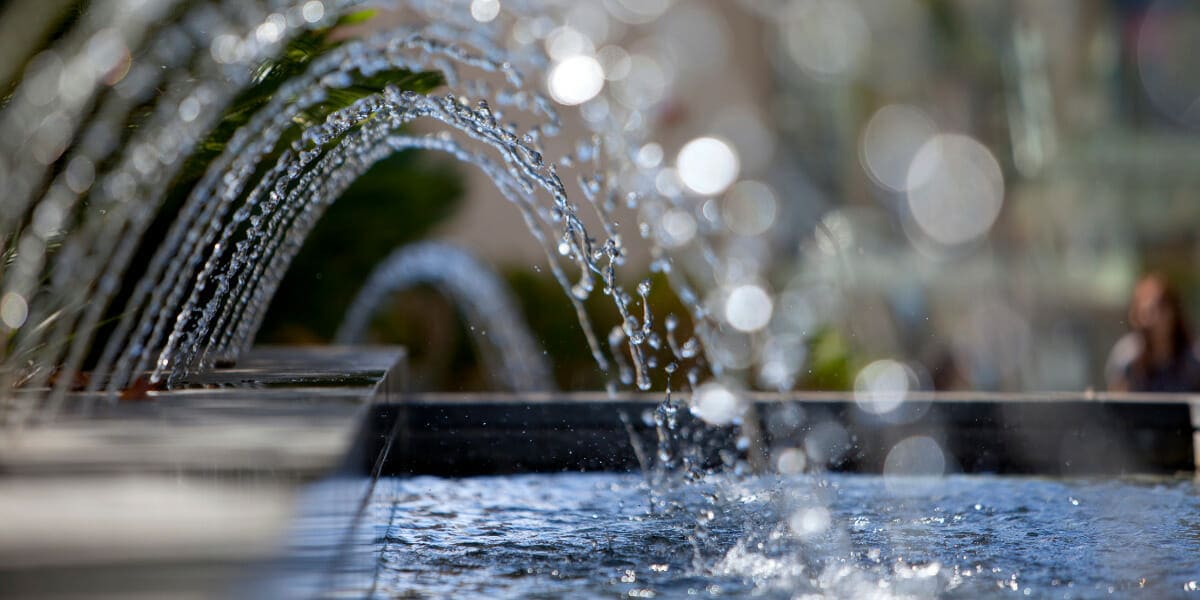
Water features
Water Features are essential to landscape design, adding charm, tranquility, and biodiversity to outdoor spaces.
- Ponds and Fountains: Ponds, whether small or large, bring a touch of nature to any landscape, supporting aquatic plants and wildlife. Fountains, on the other hand, provide soothing sounds and a focal point for gardens. Both offer opportunities for creative design with various shapes, sizes, and materials. Ponds can host colorful fish, while fountains feature intricate sculptures or modern, minimalist designs.
- Birdbaths and Streams: Birdbaths are aesthetically pleasing and attract a variety of bird species, enhancing the ecosystem’s diversity. Streams, whether natural or artificial, introduce dynamic movement and the soothing sound of flowing water. They can be incorporated into gardens, meandering the landscape, or as an aquatic focal point. These elements contribute to a harmonious and balanced environment, promoting relaxation and enjoying nature’s beauty.
- Outdoor furniture and lighting
Outdoor furniture and lighting play a crucial role in enhancing the aesthetics and functionality of any outdoor space. When selecting outdoor furniture, it’s essential to consider both style and durability. Opt for teak, wrought iron, or weather-resistant wicker that can withstand the elements while complementing your landscape design.
Choosing the right pieces involves assessing your outdoor needs, whether a dining set for al fresco meals, lounge chairs for relaxation, or a cozy bench for a garden nook. Ensure that the selected furniture pieces align with the overall theme of your landscape.
Proper placement is equally important. Arrange seating areas to maximize comfort and take advantage of scenic views. Strategic placement of lighting fixtures can create ambiance and extend the usability of your outdoor space into the evening hours. Pathway lighting not only adds a safety element but also adds charm to your landscape.
Budgeting and Materials
Budgeting and Materials are pivotal aspects of any successful landscaping project.
- Estimating your budget: Before embarking on any landscaping endeavor, it’s essential to establish a realistic budget. Consider factors like the size of your project, labor costs, and material expenses. Allocating funds for unexpected contingencies is also prudent.
- Cost-effective landscaping materials: Suitable materials are crucial for staying within your budget. Opt for durable, cost-effective options like recycled or reclaimed materials, which can offer a sustainable and budget-friendly solution—additionally, research local suppliers and wholesalers for discounts.
- DIY vs. hiring professionals: Deciding whether to DIY or hire professionals can significantly impact your budget. While DIY may seem cost-effective, it requires time, effort, and equipment. On the other hand, professionals have the expertise to complete tasks efficiently, potentially saving you money in the long run by avoiding costly mistakes.
Balancing your budget with quality materials and the right approach to labor ensures a successful and cost-effective landscaping project.
Planning and Layout
Sketching your design
“Sketching your design” is a crucial step within the broader domain of “Planning and Layout” when embarking on any creative project. Whether you’re designing a building, a website, or a piece of artwork, this initial sketching phase sets the foundation for your entire project.
- Using graph paper or software tools: The choice between traditional graph paper and modern software tools largely depends on the nature of your project. Graph paper offers a tangible, tactile experience, allowing you to quickly jot down ideas, while digital tools provide flexibility and precision. These tools enable you to experiment with colors, shapes, and dimensions, ensuring your vision takes form quickly and adaptably.
- Mapping out the features: Your initial sketches should focus on mapping out your design’s key segments and elements. This includes defining the layout, spatial organization, and visual hierarchy. You create a visual roadmap that guides your project’s progression by outlining these fundamental aspects. Additionally, this phase encourages brainstorming and iteration, enabling you to refine your design before committing to the finer details.
Essentially, “sketching your design” is the cornerstone of effective planning and layout, offering a clear starting point for turning your creative ideas into a tangible reality.
Considering maintenance
Maintenance is a pivotal aspect of planning and layout in landscaping, ensuring that outdoor spaces remain vibrant and attractive with minimal effort. To achieve this, strategic decisions must be made. Firstly, the placement of low-maintenance plants is paramount. Homeowners can significantly reduce upkeep demands by selecting flora that thrive in local conditions, require little pruning, and are resistant to pests and diseases.
Secondly, easy access to watering and care is essential. Installing an efficient irrigation system with automated timers can streamline watering, ensuring plants receive adequate moisture without constant manual attention. Creating well-defined paths and clear access points to garden beds simplifies routine maintenance tasks like weeding, pruning, and fertilizing.
Incorporating these elements into the planning and layout minimizes the time and effort required to maintain the landscape. It enhances the overall enjoyment and longevity of the outdoor space, making it a sustainable and aesthetically pleasing investment.
Plant Selection and Care
Plant selection and care are crucial aspects of gardening and landscaping, contributing to the health and vitality of your outdoor space.
- Choosing native and climate-appropriate plants is fundamental as these species adapt to local conditions, requiring less maintenance and water conservation. They also support local wildlife and biodiversity.
- Grouping plants with similar needs helps create efficient watering and care routines. It ensures that plants with similar sun, soil, and water requirements are placed together, simplifying maintenance.
- Proper planting techniques are essential for plant establishment. This includes digging the right-sized hole, adding compost or soil amendments, and avoiding planting too deep or shallow.
- Watering, mulching, and fertilizing tips are crucial for ongoing care. Adequate watering schedules, appropriate mulching to retain moisture and deter weeds, and judicious use of fertilizers to provide essential nutrients are all critical factors in plant health and growth.
By focusing on these aspects, you can create a thriving garden that enhances your outdoor space while conserving resources and promoting sustainability.
Installation and Maintenance
Step-by-step installation process
“Step-by-step installation process” is crucial in ensuring the successful creation and maintenance of a beautiful outdoor space.
- Preparing the soil: Start by assessing the soil quality in the designated area. Remove debris, weeds, or rocks, then loosen the dirt to improve aeration and drainage. Depending on your landscape’s needs, you may need to amend the soil with organic matter or nutrients to ensure healthy plant growth.
- Installing hardscape features: Next, focus on the structural elements of your landscape. This involves laying the foundation for paths, patios, retaining walls, or other hardscape features. Proper leveling, compacting, and using appropriate materials are essential for durability and aesthetics.
- Planting softscape elements: Once the hardscape is in place, it’s time to introduce softscape elements like trees, shrubs, flowers, and grass. Proper spacing, depth, and soil preparation are vital for root development and long-term plant health. Watering, mulching, and regular maintenance will help these softscape elements flourish and complement the hardscape features, creating a harmonious and visually appealing landscape. Routine maintenance, including watering, pruning, and weeding, will ensure your landscape remains vibrant and healthy over time.
Regular maintenance routines
Under the heading of “Regular maintenance routines,” effective installation and upkeep of various elements within a property or garden are paramount for their long-term health and aesthetics.
- Pruning and trimming: Regularly pruning and trimming trees, shrubs, and plants is crucial to encourage healthy growth, maintain desired shapes, and prevent overgrowth that can lead to structural damage. This practice not only enhances the visual appeal of a landscape but also promotes plant vitality.
- Weeding and pest control: Weeding is essential to keep unwanted plants from competing with desired vegetation for resources. Simultaneously, proactive pest control measures protect against insect infestations and diseases that can ravage a garden or landscape, ensuring the overall health and beauty of the area.
- Seasonal care tasks: Adapting maintenance routines according to seasons is vital. This involves mulching in the spring to conserve moisture and suppress weeds, fertilizing in the summer to nourish plants, and preparing for winter by insulating sensitive plants. Seasonal care guarantees the landscape thrives year-round, creating an inviting and vibrant environment.
Eco-Friendly Landscaping
Sustainable practices
“Sustainable Practices in Eco-Friendly Landscaping”
- Rainwater Harvesting: One critical sustainable practice in eco-friendly landscaping is rainwater harvesting. This involves collecting and storing rainwater for irrigation and other landscape needs. By capturing and utilizing rainwater, we reduce the demand for local water supplies and decrease the energy required for water treatment and transportation. Rainwater harvesting systems can range from simple rain barrels to more complex underground cisterns, enabling homeowners and businesses to use this valuable resource efficiently.
- Using Organic Fertilizers: Another essential element of sustainable landscaping is using organic fertilizers. Traditional chemical fertilizers can harm the environment, deplete soil quality, and leach into water systems. On the other hand, organic fertilizers promote healthy soil, encourage beneficial microorganisms, and reduce the risk of water pollution. Compost, mulch, and natural nutrient sources are excellent alternatives to synthetic fertilizers, fostering a healthier and more sustainable ecosystem within your landscape.
Incorporating these practices into your landscaping conserves resources and promotes a healthier and more resilient outdoor environment, contributing to a more sustainable and eco-friendly future.
Wildlife-friendly landscaping
Wildlife-friendly landscaping, a subset of eco-friendly landscaping, revolves around creating sustainable outdoor spaces that enhance the natural environment and offer sanctuary to various creatures. One key aspect of this approach is attracting birds and butterflies. By selecting native plants rich in nectar and berries, you can entice these colorful visitors to your garden, promoting pollination and seed dispersal.
Moreover, wildlife-friendly landscaping focuses on providing habitats for various species. Installing birdhouses, bat boxes, and pollinator hotels offers shelter, nesting sites, and resting spots for wildlife. Adding water features, like birdbaths and small ponds, further boosts your garden’s appeal to amphibians, insects, and aquatic organisms.
Embracing wildlife-friendly landscaping fosters a harmonious coexistence between your outdoor space and the local ecosystem. Beyond aesthetic appeal, this approach promotes biodiversity, balances the food chain, and contributes to the planet’s health while creating a soothing and dynamic environment for your enjoyment.
Troubleshooting Common Issues
- Dealing with drainage problems is essential for maintaining a healthy garden. Poor drainage can lead to waterlogged soil, root rot, and plant stress. To troubleshoot this issue, consider improving soil quality by adding organic matter, like compost, and creating drainage channels or raised beds. Ensure that pots and containers have proper drainage holes to prevent water accumulation.
- Handling plant diseases and pests is another common challenge for gardeners. Early detection and identification of issues are crucial. To address these problems, use organic pesticides, neem oil, or soap-based solutions for pests, and practice crop rotation and proper plant spacing to minimize disease spread. Regularly inspect plants for signs of infestations or infections and promptly remove affected parts.
- Addressing design or aesthetic issues is vital for creating an attractive garden. If facing design problems, consider revising the layout, adding focal points, or adjusting the placement of plants and features. For aesthetic concerns, choose suitable color schemes, textures, and plant combinations that harmonize with your garden’s overall theme. Regular maintenance, such as pruning and weeding, will contribute to a visually appealing garden.
Conclusion
In conclusion, embarking on a DIY landscape design journey offers more than a beautifully transformed outdoor space. It serves as an encouraging platform for individuals to unleash their creativity and tap into their inner landscape artist (B). By taking the reins of the design process, homeowners gain valuable insights into the nuances of horticulture, paving the way for a deeper connection with nature and an enhanced appreciation for the environment.
Moreover, the satisfaction derived from crafting one’s outdoor oasis (C) is immeasurable. Witnessing the tangible results of personal efforts, from meticulously selecting plant varieties to arranging hardscape elements, fosters a profound sense of achievement and pride. This pride extends beyond aesthetics; it encompasses the knowledge that one has contributed positively to one’s living environment, fostering a greater sense of attachment to one’s home. In the end, the encouragement and satisfaction experienced through DIY landscape design are transformative for the outdoor space and the individuals who embark on this creative and fulfilling journey.

